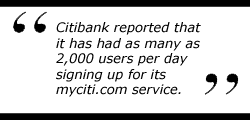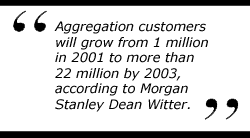Run for the Money: The Battle for Online Aggregation Business
Banks, brokerages, and financial portals are racing to grab a piece of the booming market for aggregation services. Traditional institutions have the lead — but they can't afford complacency.
People with a yen to check up on their bank, brokerage, credit card, and even frequent-flier accounts can go to the Web to see where they stand. But there's a problem: It's hard to make financial decisions based on a complete picture of all your accounts, because statements scattered across many different Web sites can't be viewed, much less analyzed, at the same time.
That consolidated view, however, is exactly what growing numbers of consumers want. During the past year, Web sites of traditional banks and brokerages and emerging personal finance Internet portals have been racing to provide a remedy called aggregation. Aggregators collect data from an individual's multiple accounts and upload it to a single location on the Internet.
Last week Charles Schwab & Co. was the latest brokerage house to announce it will offer account aggregation through its Web site, Schwab.com. Other leading financial institutions offering these services include Citigroup, Inc., Wells Fargo, Merrill Lynch & Co., and Morgan Stanley Dean Witter & Co.
But a new, in-depth Booz-Allen & Hamilton study of consumers who aggregate their accounts online found that e-branded personal finance portal sites such as Yahoo Finance, OnMoney, MSN's MoneyCentral, and America Online (cobranded with Quicken) are jockeying to give well-known banks, brokerages, and other established players a run for their money — and their customers. Brand-name financial institutions can't assume existing customers will automatically prefer their aggregation tools. Further, security and privacy are major concerns that could stall the use of this promising technology.
Supply and Demand
In theory, everyone wins with aggregation. Customers get one-click access to all their financial information, while service providers get an extraordinary peek at customers' money situation, which they can use to cook up tempting individually tailored offers. Think along these lines: "Tired of paying 10% APR on your BigBank credit card? Click here and you'll get one for 5% plus a low-rate loan for your kid's upcoming tuition payment."

According to the new Booz-Allen & Hamilton and e-Rewards survey of 1,001 aggregation-service users and 1,900 general Internet users, the number of users of aggregation services exploded in 2000 from 10,000 in January to 700,000 in December. Citibank reported that it has had as many as 2,000 users per day signing up for its myciti.com service.
However, the finding that raised the most eyebrows: Although banks attract the most aggregation customers (41 percent of respondents aggregate at banks), 33 percent of respondents use portals not tied to major financial institutions, which don't offer mortgages, checking accounts, and other services. This means that portals are attracting a solid chunk of a very attractive customer segment — people who are relatively young (average age of 36), affluent, and Web-savvy. Half the early adopters of aggregation services represented in the survey have incomes between $75,000 and $149,999. And compared to the general Internet-user respondents, the survey showed aggregation customers are more likely to go online to research and buy financial products.
Run for the Money
The survey suggests that traditional financial institutions risk losing the mindshare of customers who aggregate their accounts at financial portals. Specifically, it showed that 36 percent of portal customers spend less time at the Web sites of the institutions where they have checking, brokerage, and other accounts, while 9 percent stopped visiting these sites entirely.
The upshot: Once customers aggregate elsewhere, their connection to their financial institutions starts to slip, and they become targets for competitive offers. Indeed, the survey found that aggregation customers are receptive to offers tailored to their financial profiles (39 percent called such offers "very valuable").

What leads users to centralize their accounts at a particular type of site? Sixty-eight percent of respondents mentioned their existing relationship with a financial institution, revealing that banks, brokerages, and other traditional financial services providers have a major advantage in the scramble for aggregation customers. By contrast, no single factor steered people to portals; 26 percent of portal users said they signed up at the first site they found that offered aggregation.
Furthermore, only 18 percent of portal customers cited an existing relationship with the portal. This suggests that portals are using their status as heavily trafficked destinations to educate online users about aggregation services, and then sign them up. Financial institutions can fight back simply by getting a solid aggregation program in front of curious customers before a portal catches their eye.
Battling Business Models
In one sense, established financial institutions and the emerging personal finance portals are both supplying a commodity service, since most license the underlying technology from Yodlee.com Inc., the leading provider of aggregation technology. Both must also achieve a high level of customer trust to win aggregation business — a quarter of respondents said trust in the company name associated with the Web site influenced their decision to use a particular aggregation service.

But the game gets more interesting and complicated as aggressive companies surround their core offering with other services, branding, and incentives that take them far beyond a bland "me-too" positioning. E-portals and bricks-and-clicks institutions can draw on specific strengths in the quest for new customers:
- Portals can be independent advisors. By definition, portals don't offer their own financial services. They do, however, have strong brands and skills at pulling together information. Smart portals could parlay these factors into a brand positioning as an independent "trusted advisor" that gives aggregation customers advice and offers from third-party financial companies. OnMoney, for example, has tools to help users select an online broker. The challenge for portals is how to profit from these tools. Users will not be a direct source of revenues, since few are willing to pay even a token fee for the service, according to Forrester Research. That leaves portals with a service that's free for customers but expensive for the portals themselves (due to licensing fees for the underlying technology and annual per-user fees). Advertising is currently a significant source of revenue, but longer term the economics may depend heavily on commissions and referral fees.
- Financial institutions have customer relationships and multiple channels. They can win aggregation business based on their existing checking, savings, investment, and mortgage relationships. They also have a bricks-and-mortar advantage over virtual services. Branch networks, for example, are reassuring places where customers can meet advisors and learn about new offerings. Of the customers who researched financial products online, 21 percent bought products offline, at branches or through a toll-free number. This suggests banks can use their physical and telephone channels to satisfy the needs of customers who do research online but buy offline. The big question for financial institutions is whether to serve as a distributor or manufacturer of services (or to straddle both). That is, should they market third-party services or stick with house brands (e.g., Citibank offering only Travelers insurance)? Carrying third-party products (including those of competitors) promotes a fair and impartial image and might keep users from shopping at other sites.
Skills to Succeed
Whether an aggregation service provider is a pure play or a bricks-and-clicks institution, it needs skills in several areas to succeed:
Security and privacy are huge concerns, since users are putting multiple accounts on one site and providing their user names and passwords to those accounts. These issues already show signs of limiting the growth of aggregation, according to Forrester. Consumer protection and overall risk management must be bullet-proof.
Strategic innovation skills are needed to develop unique offerings, learn from experience, and rapidly adapt products and services to market opportunities. This includes balancing the mix of online/offline services in the overall offering. Enhancements such as fund transfers, consolidated bill presentment and payment services, and financial planning will distinguish sites and raise the bar for all competitors, although a winning model has not yet been defined and proven.
Customer relationship management will become an even more significant concern for traditional institutions as they lose what were once proprietary customer data to portals, and even other brick-and-clicks competitors. This represents a loss of customer control and a loss of brand equity. Established personal finance companies must maintain and strengthen existing relationships while accommodating customers' interest in aggregating elsewhere.
Emerging Market
What's the potential of the aggregation market? In September 2000, Morgan Stanley Dean Witter estimated that the number of aggregation customers would grow from 1 million this year to more than 22 million by 2003.
Still, of 47 million online U.S. households, only 0.2 percent use aggregation services. Eleven percent bank, 5 percent trade stocks, and 5 percent pay bills online, according to Forrester and the U.S. Commerce Department. Aggregation's household penetration could approach the levels of other online financial services if users are able to do more than run the numbers at aggregation sites.

Account aggregation customers are clearly ready for additional services: Financial planning and cross-institution funds transfers are two examples that have generated significant interest. The institution or portal that can wrap the basic service with these and other dynamic features will likely be the player to beat as the market develops.
| Authors
Larry Altman, altman_larry@bah.com Larry Altman is a vice president with Booz-Allen & Hamilton's Health and Insurance Group. He focuses on developing business strategies for insurance clients, helping them drive growth through improved distribution performance, stronger marketing capabilities, entry into new markets, acquisitions, and joint ventures. Anju Simon, simon_anju@bah.com Anju Simon is a principal with Booz-Allen & Hamilton in New York, serving in the Financial and Health Services Practice. Ami Bhandari, bhandari_ami@bah.com Ami Bhandari is an associate with Booz-Allen & Hamilton, based in New York. She has recently worked on projects involving financial services and the Internet. Zaki Hyatt-Shaw, hyatt-shaw_zaki@bah.com Zaki Hyatt-Shaw is a consultant with Booz-Allen & Hamilton based in New York. |

